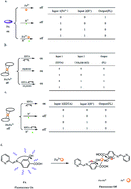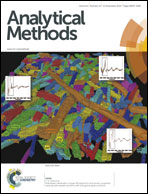Reversible multi-control fluorescent switch and molecular logic gate based on selective recognition of Fe3+ and its application to multiplex detection†
Abstract
A novel chemosensor, 2-hydroxy-4-(pyridin-2-ylmethyleneamino)benzoic acid (PA) has been developed and found to be a selective fluorescent detector of Fe3+ over a wide range of treated metal ions. Because of the presence of carboxyl in PA, the fluorescence of this Schiff base could be reversibly controlled by alternately adding OH− and H+. In addition, because Fe3+ selectively quenches the fluorescence of PA, the quenched fluorescence can be recovered by adding EDTA as a competitor or NH2OH × HCl as a reducing agent. As a result, the fluorescence intensity of PA could be reversibly turned by H+/OH− or Fe3+/EDTA or NH2OH × HCl/K2S2O8 in an aqueous solution. These results demonstrated that PA along with a PA–Fe3+ system can perform not only as a reversible multi-control fluorescent switch, but also as a “NOR,” “OR” and “INHIBIT” logic gates. Furthermore, analytical application of this fluorescent probe was investigated and achieved promising and satisfying results.


 Please wait while we load your content...
Please wait while we load your content...